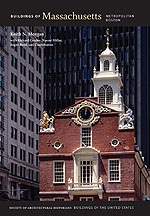
Boston and the Atlantic have been interlinked from the colony's beginning, but rocky and shallow shoals made the approaches by sea hazardous, with great loss of life and cargo. Three lighthouses in Boston Harbor mirror a rich history of evolving technology.
Boston Light (NHL, NR), the site of the first lighthouse (1713–1716) in North America and the nation's second oldest tower (1783) marks the easternmost approach to the harbor. In June 1776, the British, while evacuating Boston, finally succeeded in blowing up the first tower. The seventy-five-foot replacement (1783), built of rubble stone with attached entrance room, was stabilized in 1809 by six highly visible black iron bands; in 1844, a cast-iron circular staircase was inserted in the tower. Upon this rises an 1856 brick addition to the height of eighty-nine feet and a full-length glass lantern room to house the 1859 technologically advanced Fresnel optic of beehive-shaped concentric lead-glass rings and with a rotating beam that reaches twenty-six miles out to open sea. In 1852, a bell was installed to replace the “great gun” that had warned ships during fogs since 1719. A rare, large, wooden, double-rain cistern building (1884) and the brick fog signal structure (1876) flank the tower. At a safe distance from the tower, the double keeper's house (1885) is a typical, small, fireproof brick oil house with a slate roof (1876). The boathouse (1899) and recently rebuilt concrete pier on riprap construction greet scheduled summer harbor boat service. Today, Boston Light remains the only actively worked station, with its complex illustrating the life of keepers and their families. All other American lighthouses have been automated or decommissioned.
Boston's second lighthouse, Long Island Head Light (1819, NR), an inner-harbor light fifty-two feet high, is a typical
The Graves Light (NR) guarded the northern hazards when sailing into or bypassing Boston. A late example (1905) of exposed construction (inaugurated at the Eddystone Light, England, 1755), it was seriously damaged in a 1991 storm. A granite block, 113-foot conical tower contained stores and water below, with upper levels as living quarters for the male keepers who rotated from tower duty to their families in the town of Winthrop. The tower door is reached forty feet up from the base. The oil house, on a separate rock outcropping, was reached by a walkway, now demolished. Before automation, the full-length














